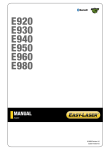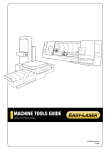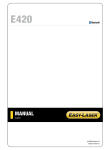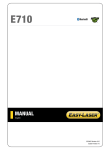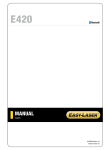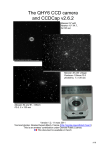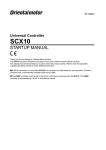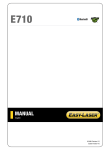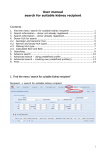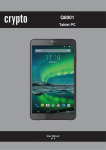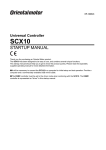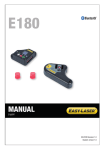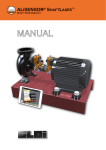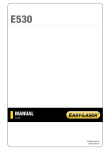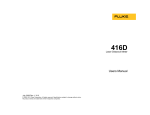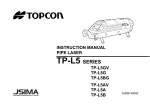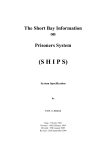Download E910 E915 - Alignment Supplies, Inc.
Transcript
E910 E915 MANUAL FLANGE English 05-0400 Revision 2 Content Introduction User Interface 7 11 Navigation buttons 12 OK buttons 12 Function buttons 12 Screen dump 12 Status bar 13 LED signals 13 Battery 14 Display unit 14 Detector 14 Bluetooth units ® 14 Calculator 15 Measurement file handling 16 Save measurements 16 Open measurements 16 Copy to usb memory 16 Generate PDF reports 16 Download to PC 16 Settings 17 Filter 17 Unit and resolution 18 Detector rotation 18 Date and time 18 Language 18 User 19 Backlight 19 Automatic power off 19 Information 20 System update 20 Bluetooth® 21 General information 23 Values 25 Values target 25 Register values 25 Halve or Zero set value 26 Zoom 26 Tolerance 26 Values table 27 Function buttons 27 Automatic recording 28 Flange flatness 29 Set up 30 Measuring procedure 31 Enter distances 31 Measure 31 Flange result 32 Flange 3D view 32 Flange Graph view 32 Flange Table view 32 Reference points 33 Taper result 35 Flange parallelism 37 Set up 38 Measuring procedure 39 Enter distances 39 Measure point 1 to 4 39 Measure point 5 to 8 40 Function buttons 40 EasyLink™ 41 Install and setup 42 Working with EasyLink™ 44 Flange program 47 Technical data 51 Display unit E418 52 Laser transmitter D22 53 Laser transmitter D23 Spin 54 Tilting screws 54 Detector E5 55 Angular prism D46 56 Tripod 56 6 Introduction Damalini AB Damalini AB develops, manufactures and markets Easy-Laser® measurement and alignment equipment based on laser technology. We have more than 25 years of experience from measurement tasks in the field and product development. We also provide measurement service, which means that we ourselves use the equipment we develop, and continuously improve it. Because of this we dare to call ourselves measurement specialists. Do not hesitate to contact us about your measurement problems. Our expertise will help you solve it in an easy way. Declaration of conformity Equipment: Easy-Laser® product range Damalini AB declares that the Easy-Laser® product range is manufactured in conformity with national and international regulations. The system complies with, and has been tested according to the following requirements: EMC Directive Low Voltage Directive Laser Classification RoHs Directive WEEE Directive 2004/108/EG 2006/95/EC Europe: SS-EN-608 25-1-1994 USA: CFR 1040.10/11 - 1993 2002/95/EG 2002/96/EG Disposal of old electrical and electronic equipment (Applicable throughout the European Union and other European countries with separate collection programs) This symbol, found on product or on its packing, indicates that this product should not be treated as household waste when disposed of. It should be handed over to an applicable collection point for the recycling of electrical and electronic equipment. By ensuring this product is disposed correctly, you will help to prevent potential negative consequences to the environment and human health. For more detailed information about the recycling of this product, please contact your local city office, household waste disposal service or the retail store where you purchased this product. Quality certificate Damalini AB is ISO 9001:2008 certified. Certificate number 900958 Damalini AB confirm, that our products are produced according to applicable national and international regulations and standards. All components are checked before assembly and final products are tested in functionality and visually checked before delivery The calibration of the equipment fully complies with ISO9001: 2008 #7.6 7 Introduction Limited warranty This product is manufactured under Damalini’s strict quality control system. Should the product fail within two (2) years from the date of purchase under normal usage conditions, Damalini will repair or replace the product free of charge. 1.Using new or refurbished replacement parts. 2.Exchange the product with a product that is new or which has been manufactured from new or serviceable used parts and is at least functionally equivalent to the original product. Proof of purchase date should be confirmed, and sent together with a copy of the original purchase document. Warranty is valid under normal usage described in the user’s manual appended with the product. The warranty comprises failure on Easy-Laser® product that could be related to material and/or fabrication errors. The warranty is valid only in the country of purchase. The warranty is not valid in the following cases: • If the product is broken due to mishandling or incorrect operation • If the product has been exposed to extreme temperature, calamity, chock or high voltage. • If the product has been modified, repaired or disassembled by unauthorized personnel. Compensation for possible damage due to failure on Easy-Laser® product is not included in the warranty. Freight cost to Damalini is not included in the warranty. Note Before delivery of the product for warranty repair, it is the responsibility of the buyer to backup all data. Data recovery is not included in the warranty service and Damalini is not responsible for data that may be lost or damaged during transit or repair. 8 Introduction Safety precautions Easy-Laser® is a laser instrument in laser class II with an output power less than 1 mW, which requires the following safety precautions: • Never stare directly into the laser beam • Never aim the laser beam at anyone else’s eyes. Note! Opening the laser units can result in hazardous radiation, and will invalidate the manufacturer warranty. If starting the machine to be measured would result in injuries, the possibility to unintentionally start it must be disabled before mounting the equipment, for example by locking the switch in the off position or removing the fuses. These safety precautions should remain in place until the measurement equipment has been removed from the machine. Note! The system should not be used in explosive risk areas. Disclaimer Damalini AB and our authorized dealers will take no responsibility for damage to machines and plant as a result of the use of Easy-Laser® measurement and alignment systems. Even though great efforts are made to make the information in this manual free from errors, and to make the information complete for the user, there could be things we have missed, because of the large amount of information. As a result of this, we might change and correct these things in later issues without further information. Changes to the Easy-Laser® equipment may also affect the accuracy of the information. Copyright © Damalini 2009 19 June 2009 Fredrik Eriksson Quality Manager, Damalini AB Street Address: Damalini AB, Åbäcksgatan 6B, SE-431 67 Mölndal, Sweden Postal Address: Damalini AB, PO Box 149, SE-431 22 Mölndal, Sweden Phone: +46 31 708 63 00, E-mail: [email protected] Web: www.damalini.com 9 10 User Interface LED signals OK Navigation buttons Numeric buttons Function buttons A Connection for external power. B Network connection. C External connection. Use for projector for example. D USB A (master). Use for usb memory. E USB B (slave). Use for connecting to a PC. F Connection for Easy-Laser® equipment. G IP protection only when sealed Battery compartment A B C D E F G 11 User Interface Navigation buttons To navigate on the screen, use the navigation buttons. The selected icon is marked with a yellow frame. The navigation buttons are also used to move between the buttons in a submenu and to change the values in the fields. Navigation buttons, use the up button to take screen dumps OK button Numerical buttons OK buttons There are two green OK buttons and they both work in the same way. Press OK to select the currently selected icon for example. Function buttons The icons above the function buttons change depending on which view is currently displayed on screen. Function buttons Submenus The function buttons marked with an arrow contain a submenu. Press and hold the function button to display the submenu. Selected icon in submenu Press and hold to display submenu Screen dump It is possible to take screen dumps of what is currently displayed on screen. You can copy the screen dump to a usb memory. You can e-mail the screen dump or use it for different kinds of reports. Take a screen dump Press and hold the navigation button “up” for 5 seconds. The screen dump is saved in the file system as a .jpg file. It is named with current date and time. Copy screen dump to usb memory 1.Insert a usb memory in the Display unit. to open saved files. Select a screen dump and press 2.Select 12 . User Interface Status bar The Status bar contain additional information such as warning icon, current time and Bluetooth® connection. Status bar Measurement unit. Change units via Settings. There are also text messages regarding: • The selected icon. • Hints on what information you are expected to fill in. Status bar icons Warning. Press the function button regarding the warning. to get additional information Display unit charging. Indicating that a power adaptor is plugged in. Hourglass. The display unit is in the middle of a task. Peripheral. Indicates that a peripheral device is plugged in, such as a projector. Bluetooth®. Indicates that the Bluetooth® functionality is activated. The number beside indicates the number of Bluetooth® units connected. LED signals Right indicator Yellow Flashing: The internal battery in the Display unit is charging. Left indicator Left indicator has several functions and colours: Red/Blue Quick flashing: Reprogramming the system. Flashing: Warning, for example low battery. Red Flashing: Searching for detectors equipped with Bluetooth®. Blue Green Light blue Fixed light: Connected to detectors equipped with Bluetooth®. Flashing: Display unit is starting. Fixed light: The internal battery in the Display unit is fully loaded. Blinking: Backlight is off, but the Display unit is still on. Press any button to activate the Display unit. 13 User Interface Battery Select to display the Battery view. This view gives you a good overview of the battery status of all connected equipment. Display unit Dry cell batteries Batteries empty (or dry cells not inserted) Detector Battery charging Detector’s serial number Display unit The Display unit can be used from -10ºC to +50ºC. Charge the Display unit within the temperature range of ±0ºC to +40ºC. You can charge the Display unit via: Power adaptor With the power adaptor plugged in, you can keep on working as before. USB A PC via usb cable While you have this connection, the Display unit is blocked. Dry cell batteries When you get a battery warning, insert four R14 dry cell batteries in the battery compartment. This will prolong the power of the Display unit so that you can finish your measurement. Detector The detector is charged by the Display unit when connected by cable. If you are using Bluetooth® units, switch to cable when the detector is low. Bluetooth® units The Bluetooth® units are powered by the Detector. To save energy, the Bluetooth® units are only connected when you are using a measuring program. There is no power switch on the unit. To switch off, simply unplug the unit. See also chapter Bluetooth®. 14 User Interface Calculator 1.Press to open the calculator. 2.Use the numerical buttons and function buttons to calculate. 3.Use the OK button as equal sign. Press and hold to display sub-menu 15 User Interface Measurement file handling Save measurements Press (found under ) to save a measurement. You are prompted to select a name. The date and time will automatically be added to the file name. The measurements that you save will be available to the other users as well. Open measurements Select (found on the start view and in Settings) to open saved measurements. The File view is displayed. Here you can easily see who has saved the file, when and from which program it was saved. You see the files saved by all users. xml jpg pdf A measurement file. Select a file and press OK to open. A screen dump. A report. Copy to usb memory You can easily copy a saved measurement or other files to an usb memory. This way you can transfer it to your computer for further analysis or for printing reports. 1.Insert a usb memory. . The Open file view is displayed. 2.Press . 3.Select the file you want and press 4.A folder is automatically created on the usb memory. The file is saved in the folder F:\Damalini\archive\. Generate PDF reports In the present situation, only English is available in reports. This will be updated shortly. . 1.Press 2.Name the file and press OK. A report is generated and saved in the filing system. 3.To transfer it to a PC, copy it to a usb memory, see instructions above. Download to PC 1.Start the Display unit. 2.Connect the usb cable between the Display unit and PC. 3.While you have this connection, the Display unit is blocked. 4.View and/or copy the files to the PC. 16 User Interface Settings Select to open the Settings view. Some of the settings are personal and will be default next time you start the system. Settings view Filter Press to open the Filter view. If the laser beam passes through air with varying temperature, this may influence the direction of the laser beam. If measurement values fluctuate, this could mean unstable readings. Try to reduce air movements between laser and detector by, for instance, moving heat sources, closing doors. If the readings remain unstable, increase the filter value (more samples will become available to the statistical filter). Filter values Use as short a time as possible that still produces acceptable stability during the measurement. Default is set to 1. Normally you will use a filter value of 1-3. Filter view 17 User Interface Unit and resolution Personal setting to open the Units and resolution view. Use the navigation buttons to move Press between the fields. Set inches or millimeters and which resolution you want to use. Default is set to 0.01 mm. You can set the displayed measurement resolution to 0.001 mm. The selected unit is shown on the Status bar. Unit and resolution view Detector rotation Personal setting The coordinate system can be rotated 90º. Press view. to open the Detector rotation Detector rotation view Date and time Press to open the Date and Time view. Set the date and time. Default is set to Central European Time. (CET) Date and time view Language Personal setting Press to open the Language view. Default is set to English. Use the navigation buttons to select a language. Press OK to save changes. Language view 18 User Interface User Press settings. to open the Users view. A user account is used for storing your personal Use the function buttons to add or remove users. To switch user, simply select the user you would like to switch to and press OK. User view Backlight Personal setting Press to open the Backlight view. Use the navigation buttons to move between the fields. Press OK to save changes. When backlight is off, the left LED signal will flash to indicate that the Display unit is still on. Backlight level Adjust the backlight to make it easier to read in bright sunlight. Remember however that a high contrast consume more battery. Default is set to 50%. Reduce after Set time before backlight reduction as a way to save energy. The Display unit will be dimmed, but is still on. Default is set to Never. Off after Set time before backlight off. Default is set to Never. Backlight view Automatic power off Personal setting Press to open the Automatic off view. Select how much time before automatic power off. Use the navigation buttons to select. Press OK to save changes. Automatic power off view 19 User Interface Information Press to display the information regarding serial number and version of the equipment. Information view System update The Display unit can easily be updated with the latest program version. Note! Before making a system update, make sure that the internal battery of the Display unit is charged. The battery symbol should be at least yellow. 1.Go to www.damalini.com/download > Download > Software. 2.Download the update file you need to a usb memory. 3.Unzip the file. to display the System 4.Insert the usb memory in the Display unit and press update view. 5.Select the update file and press OK. 6.The Display unit will automatically restart when the installation is finished. 7.Do not remove the usb memory until the update is finished. System update view 20 User Interface Bluetooth® Press to display the Bluetooth view. The Display unit is equipped with Bluetooth® wireless technology, which makes it possible to measure without cables between the detector and the Display unit. Note! Diode yellow when attached correctly. Diode blue when Bluetooth® is connected The Bluetooth® unit is powered by the Detector. To save energy, the Bluetooth® units are only connected when you are using a measuring program. Set up This is only necessary when adding new Bluetooth® units to the list. 1.Attach the Bluetooth unit to the detector. to open the Bluetooth® view. 2.Press to search for Bluetooth® units. 3.Press 4.The view is updated with the Easy-Laser® Bluetooth® units you can connect to. Searching for Bluetooth® units Found Bluetooth® units Use navigation buttons to toggle between Yes and No. 5.Select the unit you want to connect to and set Auto-connect to Yes, using the navigation buttons. The unit will automatically be connected when you start a measuring program. 6.Press OK to save changes and to leave the Bluetooth® view. 7.Enter a measurement program. The Display unit will connect to the selected units. While searching, the left LED indicator is blinking with a blue light which will turn to a fixed blue light once connected. 8.An icon on the status bar will indicate how many Bluetooth® units are connected. One Bluetooth® unit connected Function buttons Connect. Use if you want to connect a unit without leaving the Bluetooth® view. Disconnect. Use if you want to disconnect a unit without leaving the Bluetooth® view. Remove. Remove a Bluetooth® unit from the list. Search for Bluetooth® units. 21 22 General information Before starting a measurement, there are several things that are good to check to ensure a good and accurate measurement. • Ensure a good measurement environment. Strong sun light, warning lights, vibrations and temperature gradients can affect the readings. • Make sure the surface is clean. • The tilting screws on the laser transmitter have to be operated carefully and according to instructions. See Technical data. • If measuring for example a flange vertically, secure the laser transmitter with a safety strap. (Part no. 12-0554) • The smaller the object you are measuring, the more important is an accurate set up and levelling. 23 Values target 24 Values Select to open the Values view. With the program Values, you can see live readings from the detectors. Values target The laser beam is displayed on the target. Live values, vertical and horizontal The detector’s serial number Angle of the detector Tolerance Current range Register values 1.Press OK to register a measurement value. to see the registered values in the Values table. See also Values table. 2.Press Function buttons Back. Leave program. Settings. Press and hold to display sub menu. Tolerance. See Tolerance on next page. Zoom. See Zoom on next page. Zero set. Set current value to zero. See Halve or Zero set value. Halve. Halve displayed value. Absolute. Return to absolute value. Values table. Switch view to Values table. 25 Values target Halve or Zero set value Use the function buttons to zero set or halve the current value. Absolute value Halve value Zero set value to return to the Press absolute value. Zero of the detector returns to the centre. to halve displayed Press value. Zero of the detector moves halfway towards the laser beam. to zero set displayed Press value. Zero of the detector moves to the laser beam. Current range Zoom Use the function button Default view (found under ) to zoom. Zoom factor is set to 2. Tolerance Use the function button (found under ) to set tolerance. It is possible to set different tolerance in vertical and horizontal direction. Zoom is set to 2 and the tolerance to 1 mm. Live values and marking displayed in green when within tolerance. 26 Values table Values table In the values table all registered values are displayed in a list, this gives you a good overview of the registered values. Use the navigation buttons to move up and down in the list. 1.Select to open the Values table. 2.Press OK to register values. Live values, vertical and horizontal The detector’s serial number Registered values Angle of the detector Function buttons Back. Return to Values target. Settings. Press and hold to display sub menu. Save. Save a measurement in the Display unit. For more information, see Measuring file handling. Automatic recording. See below. Erase. Delete all registered values from the list. Zero set. Set displayed value to zero. See Halve or Zero set value. Halve. Halve displayed value. 27 Values table Automatic recording In the Values table, it is possible to make automatic recording of values. This is very useful when you want to register values during a longer time period for example. 1.Press (Found under ) to start automatic recording. 2.Select time and interval. 3.Press OK. The recording will start and you can follow the progress on screen. 28 Flange flatness Easy-Laser® Flange systems can be used on flanges up to 40m in diameter. You can measure 1 to 5 circles of measurement points, for example inner, middle and outer circles, in order to see the taper of the flange. Each circle can have 3–180 measurement points. The program guides you graphically step-by-step through the entire measurement, which quickens the measurement process. Wing flange brackets There are several brackets available. The biggest difference depends on whether the flange is magnetic or not. 29 Set up Set up Use the program Values, Flange flatness or targets for the set up. Point one 1.Place the laser transmitter (D22 or D23) on the flange. Notice the direction, see image. 2.Place the detector close to the transmitter. 3.Make a mark to mark out the position of the detector. 4.Adjust the detector or target so the laser beam hits the centre. 5.If you use a measurement program, press to zero set point #1. Notice the direction and location of transmitter. Point number one, close to the transmitter. Zero set. Point two 6.Move the detector to point number two, see image. 7.Aim the detector straight towards the laser. 8.Adjust the laser beam by turning the screw on the transmitter’s tilt table. Level to ± 0.5 mm or better. Point three 9.Move the detector to point number three, see image. 10.Adjust the laser beam by turning the screw on the transmitter’s tilt table. Level to ± 0.5 mm or better. 90° Point number two, adjust laser beam. Adjust with this screw. Make sure all three points are still zero before measuring. Point number three, adjust laser beam. 90° Adjust with this screw. 30 Measuring procedure Measuring procedure Enter distances Make sure all three points are still zero before measuring. Select to open the Flange flatness program. Enter the flange’s distances, confirm all data with the green OK button. Number of circles Points/circle Splitting angle Diameter Start position Enter number of circles, up to five circles is possible. Enter 3-180 points. The splitting angle is automatically calculated. If you know the splitting angle, it is possible to enter this and get the number of measuring points. Enter the diameter of each circle. Select where to start measuring. If needed, the points are redistributed so that a measurement point is in level with the starting position. Measure 1.The first measurement point is marked with yellow. 2.Press OK to register measurement values. The measurement points you have registered are greyed out. Registered values Target Live values Current measurement point is marked with yellow 31 Flange result Flange result Flange 3D view Press to display the 3D view. Zero plane Measurement point #1 Reference points Taper Switch view Flange Graph view Press to display the Graph view. In this view, the result is displayed in a graph where you have a good overview of the result. Use the navigation buttons to move in the table. Button left and right will move between the columns. Currently selected measurement point Use navigation buttons to move in the table Flange Table view Max The highest value. Min The lowest value. Peak-peak Difference between Max and Min value Standard deviation Average difference between Max and Min value. Flatness RMS Root Mean Square (Numerical Flatness) Press to display Table view. Select if you only want to see the table. Use navigation buttons to move in the table. 32 Flange result Reference points Press and hold to display calculation settings. You can try different scenarios to see which one suits the best and analyze the measurement result directly in the Display unit. Reference point Set currently selected point to zero. Raw data Revert to original data. 1 ref point Measurement point #1 is set to 0. 3 ref points Three reference points are set to zero. One is set on measurement point #1 and the other are distributed evenly on 120º. Best fit around 0 The best fit around 0 is calculated on the selected circle in the table. All positive The best fit with all measurement points above 0 is calculated on the selected circle in the table. All negative The best fit with all measurement points below 0 is calculated on the selected circle in the table. Set custom reference points 1.Select a measurement point in the Table view or Graph view. to set currently selected point to zero. 2.Press 3.Select one or three reference points. When you select a second reference point, the values are not recalculated. Set a third reference point to recalculate the values. One reference point selected, using . Three reference points selected, using . Set reference points automatically You can set one or three reference points automatically. Press to select first point as reference. Press to set three reference points. 33 Flange result Best fit around 0 The best fit around 0 is calculated on selected circle. Best fit around 0, using Same calculation but presented in Graph view. . All positive The best fit with all measurement points above 0 is calculated on selected circle. Best fit, all negative, using . All negative The best fit with all measurement points below 0 is calculated on selected circle. Best fit, all positive, using Note! . You can save reports with different settings for best fit to analyze further later. 34 Flange result Taper result Press to display Taper view. Here you get a good overview of the inclination of the flange, between the two measured circles. Taper values are displayed both as graph and table. Use navigation buttons to move in the table. Taper graph view Taper table view Switch between the views 35 Flange result 36 Flange parallelism Easy-Laser® enables you to measure and check the parallelism of the flanges. In addition to the standard equipment, two tripods and an angular prism are required. For this kind of measurement you need the D22 laser transmitter which is included in the E910 system. Angular prism D46 is used for parallelism measurement of the flanges. It deflects the laser beam 90°. Tripod for use with angular prism D46 and laser transmitter D22/D23. Unparallel flanges 37 Set up Set up Laser set up 1.Mount the laser on the tripod, on the same height as centre of tower. 2.Place the detector close to the transmitter. 3.Adjust the detector on the rods so that the laser beam hit the centre of detector target (within ±0.5 mm). 4.Move the detector to the other side of the flange. Adjust laser beam by using the tilt screw on the transmitter. 5.Move the detector to the lowest position on the flange. 6.Turn the laser beam towards the detector and adjust by using the other tilt screw on the transmitter. 7.Repeat 1 to 6. Prism set up 1.Place an angular prism (D46) on a tripod beside the other flange. 2.Switch the laser beam to point alongside the tower. 3.Switch the prism away to let the beam hit the target. 4.Slide the prism toward A and adjust with B and C until the target is concentric to the laser beam. 5.Slide the prism away from A and adjust with D and E until the target is concentric to the laser beam. 6.Repeat 4 and 5. 7.Switch the prism in, tighten the locking knob and measure. Now the angular prism can be moved to a new position on the sliding way to aim the laser beam to the detector. Laser beam out Vials for rough alignment B Vertical adjustment Locking knob for fine turning Laser beam in Target Fine turning screw A Horizontal tilt C D Tilting plate Locking knob Vertical tilt E Horizontal adjustment Press here to switch the prism away. Sliding way for transversal working range Angular prism mounted on tripod 38 Measuring procedure Measuring procedure Enter distances 1.Select to open the Flange parallelism program. 2.Enter distances between the measurement points. 3.Press OK. Measure point 1 to 4 1.Press OK to register values on #1 and #2 on the first flange. The yellow marker on the screen guides you where to put the detector. 2.Switch beam 90º. Use the angular prism to angle the laser beam. 3.Press OK to register values on #3 and #4 on the second flange. Target Registered values Live values Result When you have registered #1 to #4, a result is displayed. Result Press to continue measuring 39 Measuring procedure Measure point 5 to 8 1.Press to continue measuring. 2.Rotate the tower section 90º. 3.Switch beam back to first flange. 4.Measure point #5 and #6 on the first flange. 5.Switch beam 90º to second flange. 6.Measure point #7 and #8 on the second flange. Press to continue measuring Rotate tower section Result When you have measured all points, a result is displayed. Function buttons Back. Leave program. Settings. Press and hold to display more buttons in a sub-menu. Generate PDF. For more information, see Measuring file handling. Save. Save a measurement in the Display unit. For more information, see Measuring file handling. Zero set. Set current live value to zero. Absolute. Return to absolute value. Continue. Continue measuring point 5 to 8. 40 EasyLink™ EasyLink™ is a data transfer and database software for Windows. The export function supports Excel, Works and Lotus. The import function supports, besides Easy-Laser®, also measurement systems from some other manufacturers. Up to 16000 measurements per database can be handled by the program. System requirements • Windows® NT, 2000, XP and Vista. • RAM: 256 MB • Free hard disk space: 50 MB. • Serial cable – null modem type (serial LapLink cable). The length of the cable should not exceed 3 meters. Update EasyLink™ For the best functionality the EasyLink™ program should be upgraded continuously. Make sure you have administration rights before you start the update process. Do as following: 1.Select Help >Update via internet. A dialog is displayed. 2.Click OK. Your internet browser starts*. 3.In the next dialog, select Save to disc. 4.Download the file to C:\Program\Well (which is the default EasyLink™ folder) 5.Select Start > Run and browse for the file C:\Program\Well \Update.EXE. * Some browsers do not support this function. In that case you have to download the file manually from www.damalini.com instead. 41 EasyLink™ Install and setup You can download the EasyLink™ software from our web site, or use the Easy-Laser® CD to install the program. Install 1.Place the Easy-Laser® CD in the CD drive of your PC. The presentation program that also includes the installation files for EasyLink™ will normally start automatically. 2.Choose language. 3.Click EasyLink Software. 4.Choose type of installation (”full installation” if this is the first time the program is installed). 5.Click Next in the following dialogs until the program installation starts. 6.Click Finish. 7.Remove the CD from the CD drive. 8.When installation is complete the program icon appears at the desktop. You can also find the program in the Start menu. Note! If the CD doesn’t start automatically, do as follows: 1.Click Start >Run. 2.Type ”D:\ Software \ Easylink \ Install.exe”. 3.Click OK. Register The first time you start EasyLink™ the following form is displayed. 1.Enter registration data. 2.Select the check box Request activation code. Your local supplier will provide you with the code. Note! For full EasyLink™ Flange functionality, you need the activation code. It will be sent to you within a few days. 42 EasyLink™ Setup 1.Start the EasyLink™ on your PC. The Main window is displayed. 2.Select Settings >Options. The Options dialog is displayed. Graphic functions Select or deselect check boxes depending on which calculation functions you want to display. Export type Select to which format you want to export your measurement data. Communication Select the Com-port to which the serial cable is connected. Only available ports can be selected. Note that a port that appear to be available sometimes can be assigned to camera or phone programs in your PC, which makes it necessary to reconfigure these. You may also try to free the port with the “Help me find the port” function. Database Select database or return to the default database. Print Select check box to use Excel for printing reports. 43 EasyLink™ Working with EasyLink™ After installing the software, you can transfer measurement data from the Display unit to your PC. Note! When transferring data to a PC, be sure that there are no reference points set, otherwise the EasyLink™ program cannot calculate absolute values. Start EasyLink™ 1.Connect the Display unit to your PC using the usb cable. 2.An explorer window is displayed. Ignore or close this window. 3.Start EasyLink. Main window is displayed. Unsort button Saved measurements Double-click to display measurement window Kind of measurement Sort saved measurements Click the headers in the Saved measurements list to sort it. To return to unsorted list, click the Unsort button. Measurement window Double-click a saved measurement to display graphic reports in the measurement window. Picture window Data window Buttons Copy picture Click to copy the picture currently displayed in the picture window. You can paste the copy into Word for example. Print report Click to make a printout of the picture window and the data window. Main Click to return to Main window. 44 EasyLink™ Print You can choose to print the either the picture window or both picture and data window. • Select File >Print report to print both. • Select File >Print picture to print only the picture window. Printout of the picture window Copy to other programs You can copy the data and picture window to other programs such as Word or Excel. • Select Edit > Copy value list to copy only the data window. • Select Edit > Copy picture to copy the picture. Or click the button Copy picture. Select Ctrl+V to paste it into your document of choice. Word document with Picture window pasted. 45 EasyLink™ Mail results You can send measurement results via e-mail. 1.Select a result in the result list. 2.Select Advanced > Send… 3.The measurement data is pasted into an e-mail. 4.To import a measurement from an e-mail, copy the text in the mail and select Advanced > Import measurement from e-mail. Note Large measurements might not be pasted automatically. In that case the data is saved in the clipboard. You have to manually paste it into the mail. Export data to Excel 1.Click a measurement in the list. 2.Select File > Export to spreadsheet. Or right-click on a measurement in the list. The User input form is displayed. 3.Enter valid data and select a flange type from the drop-down list. 4.Click OK. 5.The report is displayed in Excel. 46 EasyLink™ Flange program To use this functionality, you need to have the EasyLink™ software installed and activated. To activate full functionality for flange, contact you local supplier. Merge two measurements If you have two separate measurements for the inner and outer circle on a flange, you can merge them into one. 1.Select a result from an inner circle measurement in the result list in the start window. 2.Select Advanced > Select as Inner circle. 3.Select a result from an outer circle measurement in the result list. 4.Select Advanced > Select as Outer circle. 5.Select Advanced > Concatenate and store. A new file is created and added to the top of the result list. Measurement window – Flange Double-click a result in the Measurement list to display graphical reports. By default Absolute reading is displayed. Click buttons to display graphical reports Buttons A 1 2 3 B C + - Absolute reading. Select one point offset. This function can be used if measurement is done with levelled laser. Not available. Select three arbitrary reference points. Best fit around zero. No reference points used. Best fit around zero. Three reference points are calculated, placing plane as close as possible to zero. Displays best plane with all measurement values positive compared to three reference points. Displays best plane with all measurement values negative compared to three reference points. 47 EasyLink™ Excel report Select File > Export to spreadsheet, an Excel report is opened. By default the Result tab is opened. There are several tabs in the report. Def tab Displays the information you see in the User input form, which is displayed when you select File > Export to spreadsheet. You can change the predefined fields and add new flanges in the form, see Template. Indata tab Displays all the data measurement. The data is displayed both in a list and in a graph. Taper tab Show the difference between the measurement points in the outer and inner circle. The flange should lean a little bit inward for best result. Short Waviness tab Show the difference between two adjacent measurement points. The data is displayed both in a list and as a graph. This is measured on the outer circle. Long Waviness tab Show the difference between all measurement points within 90º. Best fit tab Best fit will balance the plane to the best result. Result tab By default, this tab is opened when you open a report. Summary tab Shows a summary of all measurement results. The fields in green are within the tolerance. Fields in red are outside the tolerance. Summary tab Result tab 48 EasyLink™ Template The report is based on a template delivered with the system. The template file is called flg.xls and located in C: /Program/Well/Template. The template is locked except for the Def. Tab. Result template tab All calculations in the result tab are based on predefined variables, see image below. If you wish to add or alter anything in the result template tab, please contact Damalini AB. Def template tab Here you can add flanges and change the predefined values displayed in the user input form. When you change anything in the template, you need to following before saving the file: • Return to the Result template tab. • Restore the cursor position to the place specified on the page. See example in image above. 49 50 Technical data System Easy-Laser® E910 Flange, Part No. 12-0525 System Easy-Laser® E915 Flange, Part No. 12-0526 A complete system contains (*optional equipment) 1 1 1 1 1* 1 1 1 1 2 1 1 1 1 1 1 1 1 2 1 1 1 1 Laser transmitter D22 (only system E910) Laser transmitter D23 (only system E915) Detector E5 Display unit Bluetooth® unit Cable 2 m Cable 5 m (extension) Cable support Safety strap for laser transmitter Targets for rough alignment Magnet base with turnable head Set of rods (6x60 mm, 6x120 mm) Manual Quick manual Measuring tape 5 m USB memory stick USB cable Battery charger (100–240 V AC) Batteries Alkaline R14 Toolbox Cleaning cloth for optics EasyLink™ Windows® program (CD) Carrying case System Relative humidity Weight (complete system) Carrying case 10–95% 12.1 kg [26.7 lbs] WxHxD: 550x450x210 mm [21.6x17.7x8.3”] Drop tested. Water and dust tight. 51 Technical data Display unit E418 In the Display unit you are guided through the measurement procedure and can save and analyze the results. A B C D E A B C D E F F Connection for charger Network connection Expansion port USB A USB B Easy-Laser® measurement equipment Display unit Type of display/size Displayed resolution Power management Internal battery (stationary) Battery compartment Operating time Connections Storage memory Help functions Environmental protection Housing material Dimensions Weight (without batteries) VGA 5.7” colour 0.001 mm / 0.05 thou Endurio™ system for unbroken power supply Li Ion For 4 pcs R 14 (C) Appro. 30 hours (Normal operating cycle) USB A, USB B, External, Easy-Laser® units, Network >100,000 measurements Calculator, Unit converter, Instruction films IP Class 65 ABS / PC / TPE WxHxD: 250x175x63 mm 1030 g Cables Type System cable Extension system cable USB cable With Push/Pull connectors Length 2 m [78.7”] Length 5 m [196.8”] Length 1.8 m [70.8”] EasyLink™ data base software for PC Minimum requirements 52 Windows® 95 or later 256 Mb RAM, 5 Mb free hard drive space Technical data Laser transmitter D22 Laser transmitter D22 can be used to measure flatness, straightness, squareness and parallelism. The laser beam can sweep 360° with a measurement distance of up to 40 metres [130´] in radius. The laser beam can be angled 90° to the sweep, within 0.01mm/m [0.5 mils/INCH]. Rotatable head with angular prism This transmitter is included in system E910. 2 Tilting screws Tilting table 1 Option 1: the laser beam is used for a 360° sweep. Option 2: the laser beam is angled at 90° to the sweep. Note! The tilting screws on the levelling table of the D22 and D23 transmitter have to be operated carefully and according to instructions. See “Tilting screws”. Type of laser Laser wavelength Laser safety class Output Beam diameter Working area, range Type of battery Operating temperature Operating time/battery Levelling range 3 x spirit vials’ scaling Squareness between laser beams Flatness of sweep Fine turning 2 x spirit vials for rotation Housing material Dimensions Weight Diode laser 635–670 nm, visible red light Class 2 < 1 mW 6 mm [1/4”] at aperture 40-metre radius [130´] 1 x R14 (C) 0–50° C appro. 24 hours ± 30 mm/m [± 1.7°] 0.02 mm/m 0.01 mm/m [2 arc sec.] 0.02 mm/m 0.1 mm/m [20 arc sec.] 5 mm/m Aluminium WxHxD: 139x169x139 mm [5.47”x6.64”x5.47”] 2650 g [5.8 lbs] 53 Technical data Laser transmitter D23 Spin Laser transmitter D23 has a motor driven, rotating head that gives a 360° laser plane. Measurement distance up to 20 metres [65´] in radius. Pressing the On button once turns on the Rotating head laser, next press starts rotation. This transmitter (motor driven) is included in system E915. Tilting screws Tilting table The laser beam is used for a 360° sweep. Type of laser Laser wavelength Laser safety class Output Beam diameter Working area, range Type of battery Operating time/battery Operating temperature Levelling range 3 x spirit vials’ scaling Flatness of sweep Housing material Dimensions Weight Diode laser 635–670 nm, visible red light Class 2 < 1 mW 6 mm [1/4”] at aperture 20 metre radius [65´] 2 x R14 (C) approx. 15 hours 0–50° C ± 30 mm/m [± 1.7°] 0.02 mm/m 0.02 mm/m Aluminium WxHxD: 139x169x139 mm [5.47”x6.64”x5.47”] 2650 g [5.8 lbs] Tilting screws The tilting screws on the levelling table of the D22 and D23 transmitter have to be operated carefully and according to instructions. Check the position of the fine adjustment screw. It should be in its nominal position appro. 2.5 mm. 1. Loosen the locking screw. 2. Adjust with the course screw to wanted position. 3. Tighten the locking screw. Digital fine adjustment to detector and read values Fine adjustment screw Course screw Locking screw 2.5 mm Visual rough alignment to (detector) target Nominal position Maximal adjustment Note! The fine adjustment screw must not exceed its maximum position. That might damage the threads of the screw. 54 Max. 5.5 mm 1. Check so that the locking screw is tightened. 2. Adjust with the fine adjustment screw to wanted value. Technical data Detector E5 Detector E5 can work with both stationary and rotating lasers thanks to our Dual Detection Technology™. Connect to the display unit via cable or wireless via Bluetooth® (accessory). The magnet base has a rotating head to align the detector to the laser transmitter. This detector is included in systems Well protected connectors E910 and E915. PSD (2 axis) Rotatable head Magnet base Detector Type of detector Dual Detection Technology™ Resolution Measurement error Inclinometers Thermal sensors Environmental protection Operating temperature Internal battery Housing material Dimensions Weight 2 axis PSD 20x20 mm [0.78” sq] Can detect both spinning and stationary laser beam 0.001 mm [0.05 mils] ± 1% +1 digit 0.1° resolution ± 1° C accuracy IP Class 66 and 67 - 10–50° C Li Po Anodized aluminium WxHxD: 60x60x42 mm [2.36”x2.36”x1.65”] 186 g [6.6 oz] Wireless connection unit (optional) Wireless communication Operating temperature Housing material Dimensions Weight Class II Bluetooth® Wireless Technology -10–50 °C ABS 53x32x24 mm [2.1x1.2x0.9”] 25 g [0.9 oz] Magnet base with turnable head (for detector) Holding power 800 N Rods for detector Length 60 mm / 120 mm (extendable) [2.36”/4.72”] 55 Technical data Angular prism D46 For measurement of squareness and parallelism. A built-in penta prism deflects the laserbeam 90°. To keep the accuracy of the prism when measuring, the prism should be aligned to the center of and parallel to the laser beam. The prism can be switched away to let the laser beam hit a target that is used for alignment of the unit. A Angular prism, rotates 360° Sliding sled B A With the rotatable angular prism you can reach the detector anywhere on the flange. B It is quick and easy to align the beam with the detector using the sled. Deflection Turning range Fine turning Sliding range Horizontal range Vertical range Tilting range Aperture size Vials scaling Threads Housing material Weight 2 arc sec. (± 0,01 mm/m) 360° 0.1 mm/m [20 arc sec.] ± 2” [± 50 mm] ± 3/16” [± 5 mm] ± 3/16” [± 5 mm] ± 2° Ø 3/4” [Ø 20 mm] 0.3° [5 mm/m] 5/8 UNC and M6 Aluminum/steel 4 lbs [1800 g] Tripod Tripod for use with angular prism D46 and laser transmitter D22/D23. The height of the tripod can be adjusted between 500 and 2730 mm. 56 57


























































